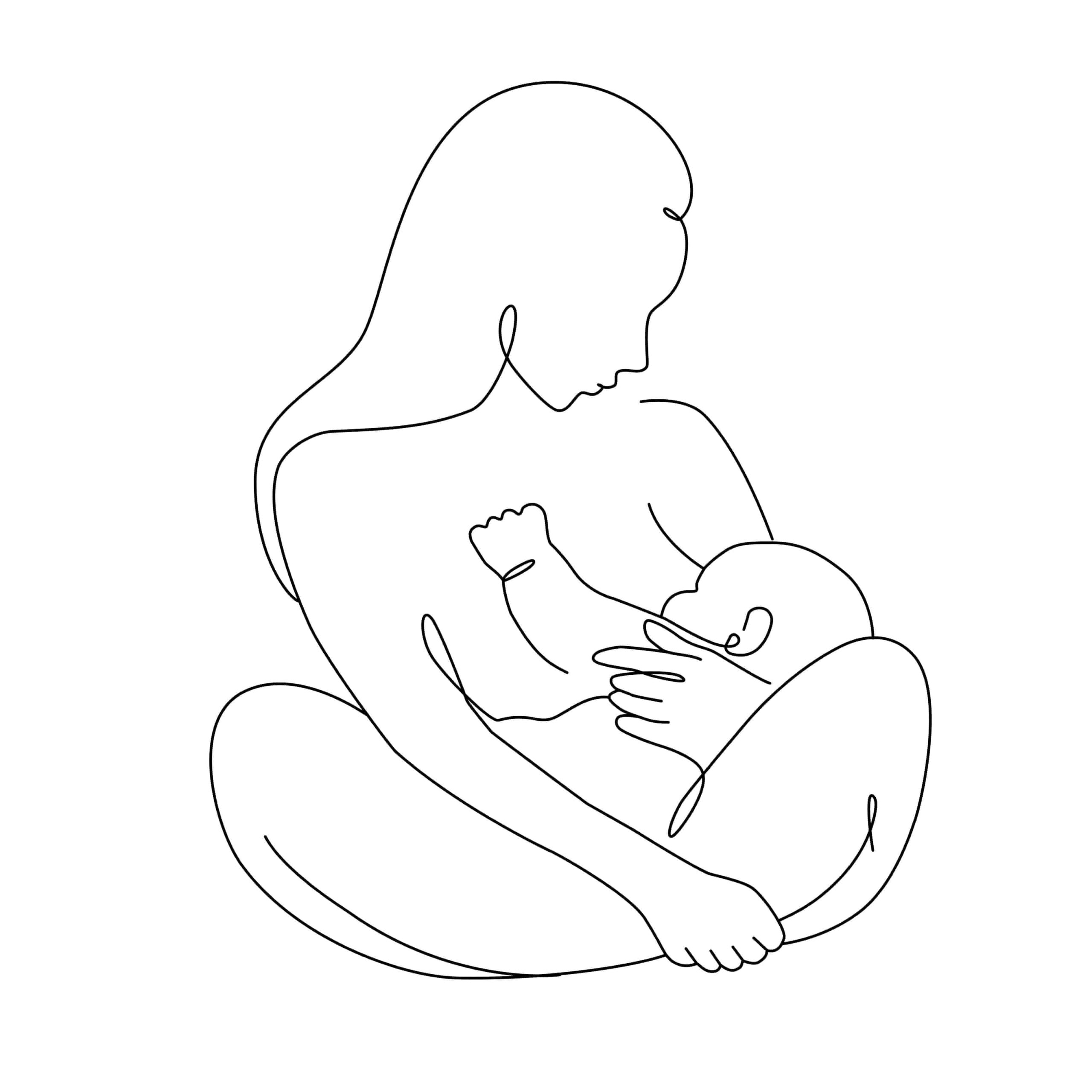Blog authored by Jessica Workman and Kat Wong
Breastfeeding is an important part of the fourth trimester of pregnancy (postpartum), and also provides nutritional, physiological, and structural development for newborns. This blog will focus on the benefits of breastfeeding (specifically for mothers), common breastfeeding positions, and various challenges of breastfeeding. If you’re already sold on the benefits and just need some help and tips, skip to heading Overcoming Challenges Associated with Breastfeeding.
Benefits of breastfeeding:
Let’s get into the many benefits of breastfeeding for moms. Several studies have shown that women who breastfeed have lower disease rates including: cancer (breast, ovarian, endometrium), endometriosis, diabetes, osteoporosis, blood pressure and cardiovascular diseases, metabolic syndrome, rheumatoid arthritis, Alzheimer disease and multiple sclerosis.
Breastfeeding also triggers a cascade of hormonal changes that benefit moms in a variety of ways. The hormone oxytocin is in continual supply during this time enabling uterine contraction. These contractions help return the organ to its normal size – reducing the risk of postpartum hemorrhage and anemia. High levels of oxytocin (the “feel good hormone”) also serve to reduce maternal discomfort during recovery, and contribute to an increased bond between a mother and her baby. Both progesterone and estrogen are suppressed during breastfeeding, while prolactin levels increase, which serve to temporarily pause ovulation. Exclusive breastfeeding provides 96% protection against pregnancy during the first 6 months. The probability of conception reduces by 7.4% for each additional month that a mother continues breastfeeding – providing a natural spacing between pregnancies.
The birth of a child is usually a source of happiness and pleasure for the family, however approximately 13% of all post delivery women may develop symptoms of postpartum depression within a period of 12 weeks following delivery. One study found that mothers suffering from postpartum depression also tended to have lower levels of oxytocin. It is thought that a stable level of cortisol may also reduce the risk of postpartum depression. Breastfeeding may also help regulate daytime cortisol levels. One theory holds that breastfeeding may help reduce cortisol and stress levels by decreasing circulating adrenocorticotropic hormone levels (the cortisol signaling hormone from the pituitary gland).
It is common for several challenges to arise following labor and delivery. The task of childcare can be physically demanding for a new mother whose body is recovering and changing postpartum. On top of this, performance of household activities, planning for return to work, diminished sleep due to childcare, changes in body image, reduced sexual activity, and the emotional pressures of trying to be a good mother all place stress on the individual. These all can be added to creating challenges for continued breastfeeding. Below are some tools to ease some of these challenges.
Image Resource: Donna Murray R. The 5 best breastfeeding positions for different situations. Verywell Family. July 15, 2021. Accessed July 16, 2023. https://www.verywellfamily.com/common-breastfeeding-positions-431648.
Overcoming Challenges Associated with Breastfeeding:
Positioning:
Positioning during breastfeeding can be a major challenge. Let’s consider some common breastfeeding positions. Here’s a lovely image from VeryWell to visually demonstrate a variety of positions that can be comfortable for both mother and baby:
Different mom’s find different positions to be most effective for them. Regardless of the chosen position, it is important that the mother align herself in as neutral, supported and comfortable of a position as possible while breastfeeding. Here are a few helpful tips:
- Bring your baby to your breast and use supports to keep them in position. Try not to lean or reach for extended periods of time.
- Support your arms while breastfeeding. Wrist and upper extremity pain is common during breastfeeding due to supporting the baby and facilitating a good latch.
- Avoid prolonged periods of time looking down. When you are looking down at your baby use your eyes as much or more than your neck.
Pillows are an absolute necessity. Specific products such as nursing pillows can also be extremely helpful.
To read more about each position, visit the La Leche League website where they dive deeper into specifics for each position:
https://llli.org/breastfeeding-info/positioning/
Latching:
Another common challenge during breastfeeding is the baby’s ability to achieve a good latch onto their mother’s nipple.
Here are some tips to help with latching:
- Hold your breast with your thumb and index finger on the edge of the areola forming a “C” (this will help with the football hold shown above), or a “U” (this will help with the cross cradle hold shown above). Squeeze the finger and thumb toward each other to compress the breast.
- When putting the baby to the breast, support your baby’s head with one hand, thumb near one ear, third finger near the other ear, and with the web of your hand at the nape of your baby’s neck.
- Tip the head slightly backwards by lifting between your baby’s shoulder blades with the heel of your hand.
- With your baby’s head tilted back and chin up, lift them to touch your nipple. The nipple should rest just above the baby’s upper lip. Wait for your baby to open very wide, then “scoop” the breast by placing the lower jaw on first.
- Now tip your baby’s head forward and place the upper jaw well behind your nipple. Keep your thumb pressing down to form the flattened sandwich as you place your baby’s upper jaw behind the nipple.
- The lower jaw will be more deeply positioned than the upper jaw. Wait several seconds, then release your breast.
- If your baby’s nose is buried deeply in the breast, tip the head slightly so you can see your baby’s nostril while the nose still touches the breast. There is no need to continue pressing the breast with your thumb.
La Leche League also has great step by step instructions for this: https://llli.org/breastfeeding-info/positioning/
Babies may also have difficulty latching if there’s a tongue tie present. This can be challenging for the baby and also be quite painful for the mom. When a baby is not able to properly latch and move the tongue with normal movements required for breastfeeding, it creates more squeezing down on the nipple rather than suction. This can lead to very painful nipples as well as difficulty for babies to get proper amounts of milk. It is very important to seek the proper team to address a baby’s tongue tie to continue breastfeeding.
Check out this website for more information about tongue ties:
https://llli.org/breastfeeding-info/tongue-lip-ties/
Another challenge with breastfeeding can be due to flat or inverted nipples. The occurrence of inverted and flat nipples is not uncommon. In an article by Alexander and Campbell in the journal The Breast they found inverted and flat nipples are common with an incidence of 16.3%. A large majority (90.2%) of women with varying nipples were able to exclusively breastfeed with adequate support. These presentations should not prevent breastfeeding if expert counseling and advice on proper positioning is provided. A nipple shield can also provide support in the case of flat / inverted nipples, as well as providing support and relief for cracked, bleeding nipples.
Image resource: Oksana. Nipple shape and breastfeeding. Lactation Clinic | Breastfeeding Consultants. Published April 17, 2019. Accessed August 17, 2023. https://lactationclinic.com/articles/nipple-shape-and-breastfeeding/
Milk Production:
Sometimes a mom’s milk expression may be affected by different aspects during labor and delivery that was out of her control. Here are some examples:
- Induction/ augmentation of labor through synthetic oxytocin
- Separation
- Medication
- Intravenous (IV) fluids
- Cesarean birth
More information can be found on each of these reasons on the La Leche Website:
https://llli.org/bridging-birth-and-breastfeeding/
There are so many changes that happen throughout pregnancy that we may tend to forget about postpartum routines such as breastfeeding. As Functional Manual Therapists (FMTs) we are uniquely trained to collaborate with other experts to help support this process. We frequently collaborate with lactation consultants, doulas, OB/GYNs, speech and language pathologist, pediatric dentists, and other professions that play important roles in facilitating a smooth transition into motherhood!
Functional Manual Therapists help educate moms about proper positioning while breastfeeding, and help ingrain optimal strategies for holding and carrying the new baby. We also help address back and neck pain associated with these tasks as well as the increased weight of the breasts that now are filling and expressing milk. FMTs trained in treating children and adults with tongue ties can also ensure that newborns receive the most optimal collaborative care to address their tongue ties.
We are here to help! If you or someone you know is pregnant or recently had a baby and has questions about breastfeeding or other postpartum care, please contact us so that we can help.






